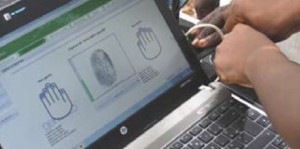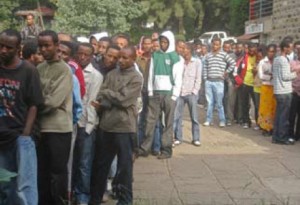Mia Harbitz is the senior expert in public registries in the Institutions for Development Sector in the Inter American Development Bank (IDB) with over 25 years of experience in development projects. Her areas of expertise include civil registration and identification, as well as vital statistics. She has contributed to a number of publications on topics pertaining to legal identity, identity management and implications of under registration, as well as books on social inclusion as a means to poverty reduction. Since 2004 Mia Harbitz has been coordinating the IDBs activities on civil registration and identity management. Among her principal responsibilities have been a series of studies assessing the practical implications of under-registration of citizens in Latin America.
Insight into the expectations and constraints of achieving a unique, secure and legal identity for all
 Population and in particular, birth registration is the responsibility of a country’s civil registry. The birth certificate is the breeder document that forms the basis for identification documents such as identity cards, passports, and e-passports by recording attributes, including unique identification numbers and biometrics. The civil registry must also provide updated and accurate data to the vital statistic system. ID People spoke to Mia Harbitz, Mia Harbitz Senior Specialist, Registries, IFD/ICS InterAmerican Development Bank the senior expert in public registries in the Institutions for Development Sector of the Inter American Development Bank (IDB) to learn how developing countries are dealing with the challenges of registration and in reaching the UN’s Millennium Development Goals (MDGs) by 2015.
Population and in particular, birth registration is the responsibility of a country’s civil registry. The birth certificate is the breeder document that forms the basis for identification documents such as identity cards, passports, and e-passports by recording attributes, including unique identification numbers and biometrics. The civil registry must also provide updated and accurate data to the vital statistic system. ID People spoke to Mia Harbitz, Mia Harbitz Senior Specialist, Registries, IFD/ICS InterAmerican Development Bank the senior expert in public registries in the Institutions for Development Sector of the Inter American Development Bank (IDB) to learn how developing countries are dealing with the challenges of registration and in reaching the UN’s Millennium Development Goals (MDGs) by 2015.
As a source of development financing for developing countries, how important is civil registration for IDB to ensure transparency and social inclusion in a democratic society?
The right to a unique, safe and legal identity is a fundamental one which gives access to other important rights. To make this right available to citizens and residents, countries need institutionally and administratively robust and independent civil and identification registries.
As the leading source of development financing for Latin America and the Caribbean, with a strong commitment to achieve measurable results, the IDB supports its member countries in their goal of reaching universal birth registration and a legal identity for all citizens and residents. In the area of civil registration and identity management, the Inter-American Development Bank has two lines of approach. Over the past decade we have built a solid knowledge base around the topic for our member countries, with both qualitative and quantitative research that supports results-based interventions. At the same time we finance initiatives to strengthen and modernize the institutional and administrative capacities of civil registries in our borrowing member countries.
How can this be achieved given inherent constraints surrounding trustworthy breeder documents and the expectations highlighted by Millennium Development Goals (MDGs)?
 The challenges surrounding a trustworthy chain of identity management starts with the civil registry. More countries are becoming aware of the civil registry’s importance and its unique role in generating reliable breeder documents and reporting vital statistics (births and deaths). One area that has been under appreciated is a civil registry’s capacity for timely and accurate reporting of births and deaths. These vital statistics are particularly significant in the country’s ability to design public sector policies and interventions. It is also important to monitor the Millennium Development Goals. The MDGS are 8 objectives with specific targets defined by all 192 UN member countries in order to improve social and economic conditions in the world’s poorest countries by 2015. Each of the targets are monitored by a set of indicators, and 10 of these are linked to reporting by the Civil registry. Considering the estimates for under registration of births and deaths, the monitoring of the MDGS may be inaccurate.
The challenges surrounding a trustworthy chain of identity management starts with the civil registry. More countries are becoming aware of the civil registry’s importance and its unique role in generating reliable breeder documents and reporting vital statistics (births and deaths). One area that has been under appreciated is a civil registry’s capacity for timely and accurate reporting of births and deaths. These vital statistics are particularly significant in the country’s ability to design public sector policies and interventions. It is also important to monitor the Millennium Development Goals. The MDGS are 8 objectives with specific targets defined by all 192 UN member countries in order to improve social and economic conditions in the world’s poorest countries by 2015. Each of the targets are monitored by a set of indicators, and 10 of these are linked to reporting by the Civil registry. Considering the estimates for under registration of births and deaths, the monitoring of the MDGS may be inaccurate.
How does this tie into the ICAO’s recommendations?
ICAO has promoted a set of recommendations for machine readable travel documents (MRTDs), which the member countries have adopted. Travel documents are civil identification documents because they contain other attributes such as a person number and biometrics that uniquely identifies the holder. There is still much work to be done to link civil registration, which is basically the registration of an individual’s biographic information, with civil identification in order to guarantee a legal, unique and secure identity from birth, for all citizens and residents.
What are some of the barriers to the successful implementation of modern and compliant ID systems and documents, with particular reference to inaccurate or missing breeder documents in developing countries?
 The challenges can be found on both the supply and demand side of the equation. On the supply side I would say that there are two principal barriers. One is the outdated legal frameworks in many countries; the other is the institutional arrangements. For instance, in some cases when the legal frameworks were approved the possibility of electronic storage and transmission of personal data was not an option. So the laws called for civil registration to be carried out on paper by the two-book system. The other barrier has to do with the agencies lack of adequate resources, both human and financial. This limits the agencies’ administrative capacity and the number of field offices to attend clients outside of the big cities.
The challenges can be found on both the supply and demand side of the equation. On the supply side I would say that there are two principal barriers. One is the outdated legal frameworks in many countries; the other is the institutional arrangements. For instance, in some cases when the legal frameworks were approved the possibility of electronic storage and transmission of personal data was not an option. So the laws called for civil registration to be carried out on paper by the two-book system. The other barrier has to do with the agencies lack of adequate resources, both human and financial. This limits the agencies’ administrative capacity and the number of field offices to attend clients outside of the big cities.
On the demand side there are also two principal barriers. The first is the cultural barrier. Unregistered citizens and residents are often among the poorest and most marginalized individuals. They often do not register their children because they do not know or understand the importance of civil registration. They may speak a different language than the country’s official language and there may be a degree of discrimination by gender or ethnicity. The second major barrier is poverty; it may be too expensive to travel to a civil registry. In addition some countries may charge fees or fines for birth registration after a certain period.
As the end goal is achieve the MDGs, what efforts are developing countries, and in Latin America in particular, taking to ensure citizens and residents have legal identities?
The IDB supports borrowing member countries in their efforts to achieve the MDGs, and in several registry projects we finance there are activities that seek to improve the timely and accurate reporting of births and deaths, allowing countries to monitor MDGs progress. At the same time, we support the right to a legal, unique and safe identity for all citizens and residents so that individuals have benefits, rights and civic obligations.
Major policy decisions are required at government level for funding and service provision. How critical are civil registries in facilitating adherence both to commitments made at this level and cooperation between public and private agencies?
 Modernization of civil and identification registries requires political will and resources, a decisions that can only be made when the decision makers understand the significant role of these agencies. Upgrading registries is becoming more urgent, given greater requirements for verification and authentication of identities, as well as the need for more accurate vital statistics and demographic information for public planning purposes. For the citizen or resident, having a unique, legal and secure identity is a safeguard to rightfully be allowed access to designated benefits, due process and the protections the legal framework may call for.
Modernization of civil and identification registries requires political will and resources, a decisions that can only be made when the decision makers understand the significant role of these agencies. Upgrading registries is becoming more urgent, given greater requirements for verification and authentication of identities, as well as the need for more accurate vital statistics and demographic information for public planning purposes. For the citizen or resident, having a unique, legal and secure identity is a safeguard to rightfully be allowed access to designated benefits, due process and the protections the legal framework may call for.
Both governments and the private sector have much to lose if identities management systems are not in place and functioning efficiently. While exact and official numbers are hard to come by, estimates indicate that the cost of identity theft, fraudulent billing, fraudulent use of healthcare or social services, may run into the tens of millions of US dollars in a country like Peru, and the tens of billions in the USA .
Secure ID documents are obligatory for governments and a fundamental citizenship right. How can a modernized registry boost ‘identity as a service’ provision to the population, rather than border security measure?
Let me respond by using a Ministry of Health that is planning vaccination campaign as an example. Firstly, if the Ministry does not know how many children were born in a given year, it is difficult to know exactly how many vaccines to procure, and where to best allocate the resources to reach all children in need. Recent research by the IDB has shown that children without a birth certificate in their first year will receive approximately two vaccines less than a baby with a birth certificate . This will have an important impact on this child’s ability to develop all his or her full potential as a human being.
In this regard, what role does an integrated approach to ID play in terms of public safety, crime prevention and the protection of human and migrant rights?
 This is a complex question, and not one easily answered given the multiple ramifications of identity management in the 21st century. With more than a billion Facebook accounts, where people voluntarily share vast amount of personal data and information, the boundaries between the private and the public sphere are being challenged, particularly with respect to ‘identifiable’ data.
This is a complex question, and not one easily answered given the multiple ramifications of identity management in the 21st century. With more than a billion Facebook accounts, where people voluntarily share vast amount of personal data and information, the boundaries between the private and the public sphere are being challenged, particularly with respect to ‘identifiable’ data.
An integrated identity document can be both a protection for the individual and the state, provided that the registry has all the safeguards for protecting the individual’s identity, and the information is only used for the purposes it was intended. Information technology is generally way ahead of privacy protection laws, and there is no easy way to align the two. Surveillance is a global phenomenon and we need a robust discussion on identity management and protection of personal data. Another related issue that needs analysis and discussion is how to strike a balance between an authority’s need to know to prevent crime and the individual’s redress options to challenge information about themselves.
The right to a legal identity, unique and safe is the most fundamental of the human rights, and an integrated ID document can support that right. The same can be said for a migrant. As long as they carry the required documentation to lawfully gain entrance to a country, they should be afforded the same rights and be protected by the same legal framework.
What lessons can be learned from current major enrolment projects in countries with large populations such as eKTP in Indonesia and Aadhaar in India?
Unfortunately I have not had the opportunity to study either of these programs up close since my geographical area of work is Latin America and the Caribbean. However, both programs show that the technology to capture, process and trace identify large populations by way of biometric attributes is achievable within a fairly short timeframe. It remains to be seen how people accept and see the benefits of the systems in their daily lives. It will also be interesting to learn how service planning and delivery by the respective Governments has improved with the introduction of the identification systems.
Is there cooperation at a supranational level by the IDB and its partners to ensure other countries and regions can benefit from these successful large scale implementations?
There is no formal supranational structure for sharing of information and lessons learned in the area of identity management. However, the IDB is a strong proponent of South- South collaboration, and we are beginning to develop the technical relationship in this area with both the African Development Bank and the Asian Development Bank, with the goal of benefiting our borrowing member countries. Furthermore, we have an extensive network of multilateral agencies and nongovernmental organizations, as well as universities and think tanks that work in the area of identity management, from birth registration to biometrics, from human rights to information technology and identity policy.
